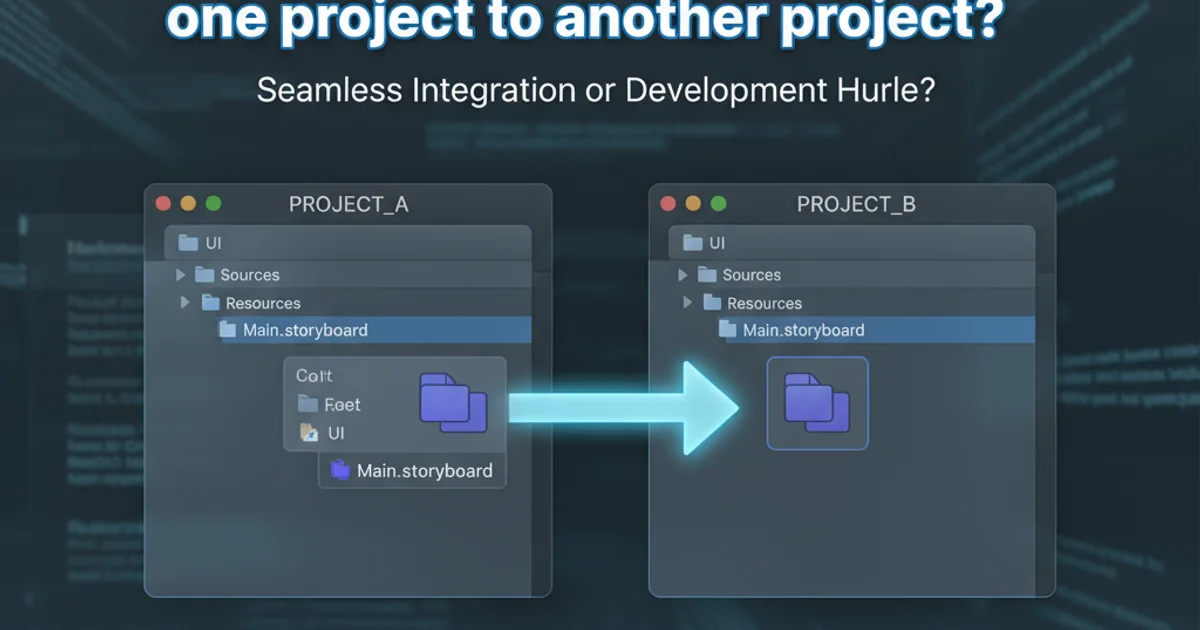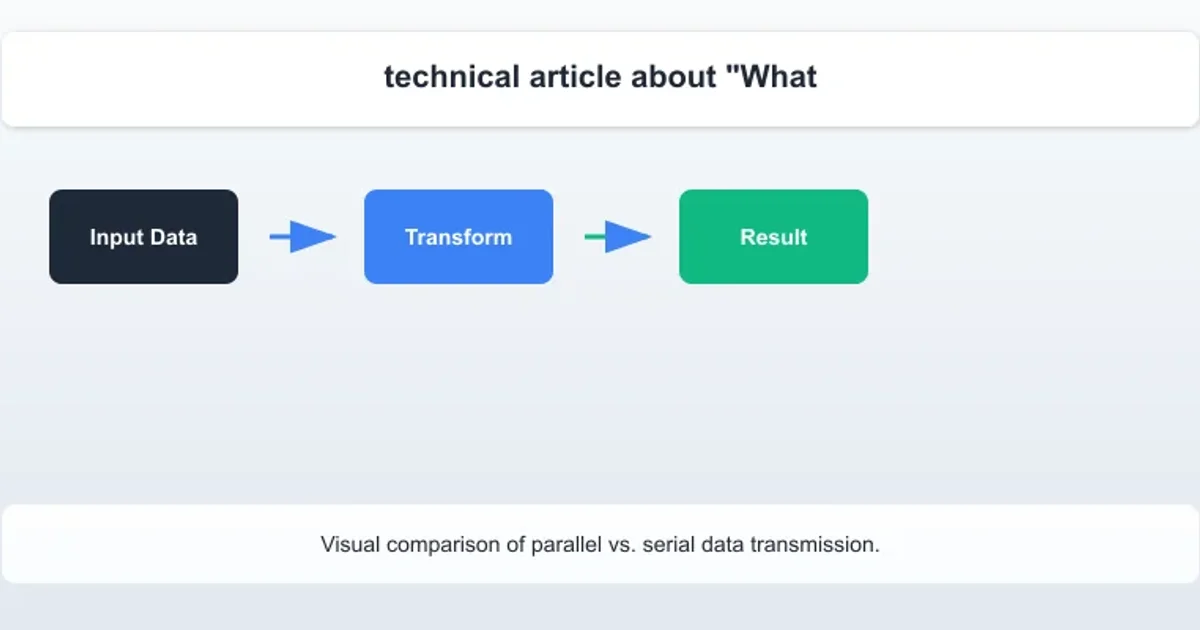What exactly is serial communication?
Categories:
Understanding Serial Communication: A Deep Dive

Explore the fundamentals of serial communication, its principles, common applications, and how it differs from parallel communication. Learn about its role in modern systems and how to interact with serial ports.
Serial communication is a fundamental method for exchanging data between two or more devices. Unlike parallel communication, where multiple bits of data are sent simultaneously over separate wires, serial communication transmits data one bit at a time over a single channel. This approach, while seemingly slower, offers significant advantages in terms of cost, complexity, and long-distance reliability, making it ubiquitous in embedded systems, industrial control, and even modern computer peripherals.
What is Serial Communication?
At its core, serial communication involves converting data from a parallel format (how computers typically store it internally) into a serial stream of bits, transmitting these bits sequentially, and then reassembling them into parallel data at the receiving end. This process requires a sender and a receiver to agree on certain parameters, such as the data rate (baud rate), the number of data bits, parity checking, and stop bits, to ensure accurate data transfer. These parameters define the 'protocol' for the communication link.
sequenceDiagram
participant Sender
participant Receiver
Sender->>Sender: Convert Parallel to Serial
loop Data Bits
Sender->>Receiver: Send 1 bit
Note right of Receiver: Receive 1 bit
end
Receiver->>Receiver: Convert Serial to Parallel
Note over Sender,Receiver: Agreement on Baud Rate, Data Bits, Parity, Stop BitsBasic sequence of serial data transmission.
Key Characteristics and Parameters
Understanding the various parameters is crucial for establishing a successful serial connection. Misconfigurations can lead to garbled data or a complete lack of communication. Here are the primary characteristics:
- Baud Rate: This is the speed at which data is transmitted, measured in bits per second (bps). Common baud rates include 9600, 19200, 38400, 57600, and 115200 bps.
- Data Bits: Specifies the number of bits used to represent each character or data unit. Typically 7 or 8 data bits are used.
- Parity: An optional error-checking mechanism. It adds an extra bit to ensure the total number of '1's in a data unit is either even (even parity) or odd (odd parity). 'None' means no parity checking.
- Stop Bits: One or two bits sent after the data bits and parity bit (if any) to signal the end of a character and allow the receiver to resynchronize for the next character.
- Flow Control: A mechanism to prevent a fast sender from overwhelming a slow receiver. Common types include hardware flow control (RTS/CTS) and software flow control (XON/XOFF).
flowchart LR
subgraph Data Frame Structure
StartBit[Start Bit] --> DataBits[Data Bits (7 or 8)]
DataBits --> ParityBit{Parity Bit (Optional)}
ParityBit --> StopBits[Stop Bit(s) (1 or 2)]
end
subgraph Communication Parameters
BaudRate(Baud Rate) --> DataFrameStructure
DataBits --> DataFrameStructure
ParityBit --> DataFrameStructure
StopBits --> DataFrameStructure
FlowControl(Flow Control) -- Optional --> DataFrameStructure
endComponents of a serial data frame and communication parameters.
Serial vs. Parallel Communication
The choice between serial and parallel communication depends on the application's requirements. While parallel communication can achieve higher throughput over short distances due to simultaneous bit transfer, it suffers from signal integrity issues (crosstalk, skew) and requires more wires, making it expensive and impractical for longer distances. Serial communication, despite sending one bit at a time, can achieve very high speeds (e.g., USB, Ethernet, PCIe) by using higher clock frequencies and sophisticated encoding schemes, and it's much more robust over long distances with fewer wires.

Visual comparison of parallel vs. serial data transmission.
Interacting with Serial Ports in Java
Java provides mechanisms to interact with serial ports, primarily through external libraries like the Java Communications API (javax.comm) or more modern alternatives like JSerialComm or RXTX. These libraries abstract the underlying operating system's serial port drivers, allowing Java applications to configure and communicate with serial devices. The process generally involves:
- Listing Available Ports: Identifying the serial ports present on the system (e.g., COM1, COM2 on Windows; /dev/ttyS0, /dev/ttyUSB0 on Linux).
- Opening the Port: Establishing a connection to the desired serial port.
- Configuring Port Parameters: Setting the baud rate, data bits, parity, and stop bits.
- Reading/Writing Data: Using input and output streams to send and receive data.
- Closing the Port: Releasing the port resources when communication is complete.
import com.fazecast.jSerialComm.*;
public class SerialPortExample {
public static void main(String[] args) {
// List all available serial ports
SerialPort[] comPorts = SerialPort.getCommPorts();
System.out.println("Available Serial Ports:");
for (int i = 0; i < comPorts.length; i++) {
System.out.println(" [" + i + "] " + comPorts[i].getSystemPortName() + " - " + comPorts[i].getDescriptivePortName());
}
if (comPorts.length == 0) {
System.out.println("No serial ports found.");
return;
}
// Choose the first available port for demonstration
SerialPort serialPort = comPorts[0];
// Open the port
if (serialPort.openPort()) {
System.out.println("Port " + serialPort.getSystemPortName() + " opened successfully.");
// Configure port parameters (e.g., 9600 baud, 8 data bits, no parity, 1 stop bit)
serialPort.setBaudRate(9600);
serialPort.setNumDataBits(8);
serialPort.setParity(SerialPort.NO_PARITY);
serialPort.setNumStopBits(SerialPort.ONE_STOP_BIT);
// Example: Write data to the port
try {
serialPort.getOutputStream().write("Hello Serial!\n".getBytes());
System.out.println("Sent: Hello Serial!");
} catch (Exception e) {
e.printStackTrace();
}
// Example: Read data from the port (non-blocking, for demonstration)
serialPort.addDataListener(new SerialPortDataListener() {
@Override
public int get ListeningEvents() { return SerialPort.LISTENING_EVENT_DATA_AVAILABLE; }
@Override
public void serialEvent(SerialPortEvent event) {
if (event.getEventType() != SerialPort.LISTENING_EVENT_DATA_AVAILABLE)
return;
byte[] newData = new byte[serialPort.bytesAvailable()];
int numRead = serialPort.readBytes(newData, newData.length);
System.out.println("Read " + numRead + " bytes: " + new String(newData));
}
});
// Keep port open for a short duration to allow reading (in a real app, this would be event-driven)
try { Thread.sleep(2000); } catch (Exception e) { e.printStackTrace(); }
// Close the port
serialPort.closePort();
System.out.println("Port " + serialPort.getSystemPortName() + " closed.");
} else {
System.err.println("Failed to open port " + serialPort.getSystemPortName());
}
}
}
Basic Java JSerialComm example for listing, opening, configuring, and communicating with a serial port.